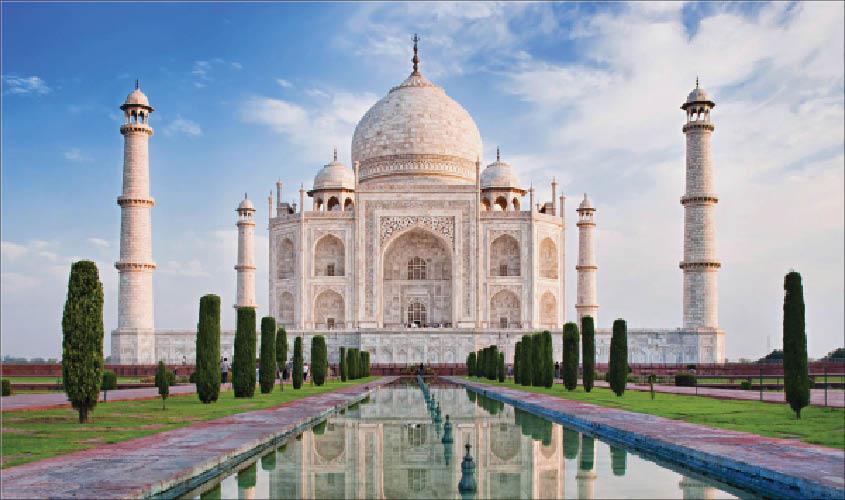Sometimes a person is born with a prophecy to have his or her name etched indelibly in history books. This is story of one such person, Arjumand Begum. Though she didn’t contribute much, she was the central figure in the building of all the three Taj monuments of India.
The story began in 1576 in Persia, now Iran. Ghiyas Beg was the son of a vizier (prime minister) of Isfahan, a province in Iran. However, after the death of his father, his family fell in disgrace and penury. So Ghiyas Beg decided to shift to Akbar’s court which was the most happening place on the continent during that time. So he embarked on his long journey from Tehran to Akbarabad (now Agra). On the way, a tragedy struck and they were robbed of all their possessions by dacoits. Left with only two mules, the family reached Kandahar (Afghanistan) in a terrible condition. Here, his pregnant wife gave birth to her fourth child, a girl. But unfortunately, they were in such a poor condition that they abandoned the newborn child at a common place. However, as luck would have it, a noble merchant working in Akbar’s court, Malik Masud, met them. He had incidentally found the abandoned child. He not only returned the child to them, but also took the whole family along with him to Agra. Taking it as a good omen and elated over the child’s luck, Ghiyas named the child Mehrunissa—the sun among women.
Malik Masud took Ghiyas Beg to Akbar and helped him secure a respectable position in Akbar’s court. Slowly, Ghiyas Beg progressed his way upwards and Akbar was so impressed by his work that he conferred the title of ‘‘Itimad-ud-Daula” (pillar of the state) on Ghiyas Beg. Ghiyas’s children, son Asaf Khan and daughter, Mehrunissa, got good education and living.
As the events unfolded, Mehrunissa got married to Akbar’s son, Jahangir in 1611. Jahangir ascended to the Mughal throne in 1605. Though Mehrunissa was Jahangir’s 20th wife, yet she was his favourite. He conferred her with the title of “Noorjahan” meaning “light of the world”. Noorjahan became all-powerful during Jahangir’s reign, which lasted till 1627. Her brother, Asaf Khan, served as Wakil (highest Mughal administrative officer) in Jahangir’s court. When Ghiyas Beg died in 1622, Noorjahan and Asaf Khan commissioned a mausoleum to be built for her father. A scintillating monument with an altogether new style, the beginning of the influx of Persian architecture in Indian subcontinent, was built on the bank of River Yamuna in Agra in 1627: the Tomb of Itimad-ud-Daula (as per ASI records). The design of this beautiful monument was copied five years later while building Taj Mahal, which was much bigger and grander.
In 1607, Jahangir’s son, Khurram (later known as Shah Jahan), got engaged to Asaf Khan’s beautiful daughter, Arjumand Begum. Shah Jahan married Arjumand in the year 1612 and conferred her the title of “Mumtaz Mahal” meaning “the exalted one of the palace”. After the death of Jahangir, Shah Jahan became emperor in 1627. Unfortunately, Mumtaz Mahal (Arjumand) died in 1631 giving birth to her fourteenth child in Burhanpur, Madhya Pradesh at the age of 38. Shah Jahan was grief-stricken. For his undying love for Mumtaz, he commissioned the building of Taj Mahal in 1631. The Taj was completed in 1643. It was much bigger, but strikingly similar to the tomb of Itimad-ud-Daula, which became known as the Baby Taj or Baccha Taj.
Mumtaz and Shah Jahan’s third son, Aurangzeb, ascended to the throne in 1657 after imprisoning his father and a bloody war with his brothers. In 1637, Aurangzeb married Dilras Banu Begum, again a Persian princess. She was Aurangzeb’s first and the most beloved wife. After giving birth to their fifth child, she died in the year 1657 at the age of 35. Unlike his father Shah Jahan, Aurangzeb was not fond of building monuments. But still, he commissioned a monument to be built for his beloved wife in 1660. He utilised the services of Ataullah, son of Ustad Ahmad Lahauri, the chief architect of Taj Mahal. As per ASI records, the monument was completed at Aurangabad in the year 1668 and was known as Bibi Ka Maqbara. Since it was so similar to Taj Mahal in Agra, it was also known as Dakkhani Taj (Taj of the Deccan). Unlike Taj Mahal at Agra, which is completely made of scintillating white marble, only the dome and few feet of the base of Bibi Ka Maqbara is made of white marble, rest is made of plaster of paris. The reason was lack of money as Aurangzeb had sanctioned only seven lakh rupees for its construction, unlike Taj Mahal in which 320 lakh rupees were spent. Though a somewhat “poorer” version of Taj, the Dakkhani Taj is also very beautiful.
So the three Taj monuments built in India between 1622 and 1668 were exquisitely beautiful and remarkably similar. Arjumand Begum (Mumtaz Mahal) was the central figure in all of them as one each was built by her father, husband and son. First, Bachha Taj was built by her father as the tomb of her grandfather; the second, Taj Mahal was built by her husband as her tomb; and the third, Dakkhani Taj was built by her son as a tomb of her daughter-in-law.
What an irony! In spite of the short life-span of just 38 years, Mumtaz Mahal was the central figure in the construction of the three most sensational monuments of all time in the Indian subcontinent. Her name has been etched in the annals of history forever, despite her negligible contribution in building of any of these monuments. Where can we see a better exemplification of prophecy and destiny?
Dr Pankaj Garg is an internationally renowned colorectal surgeon

